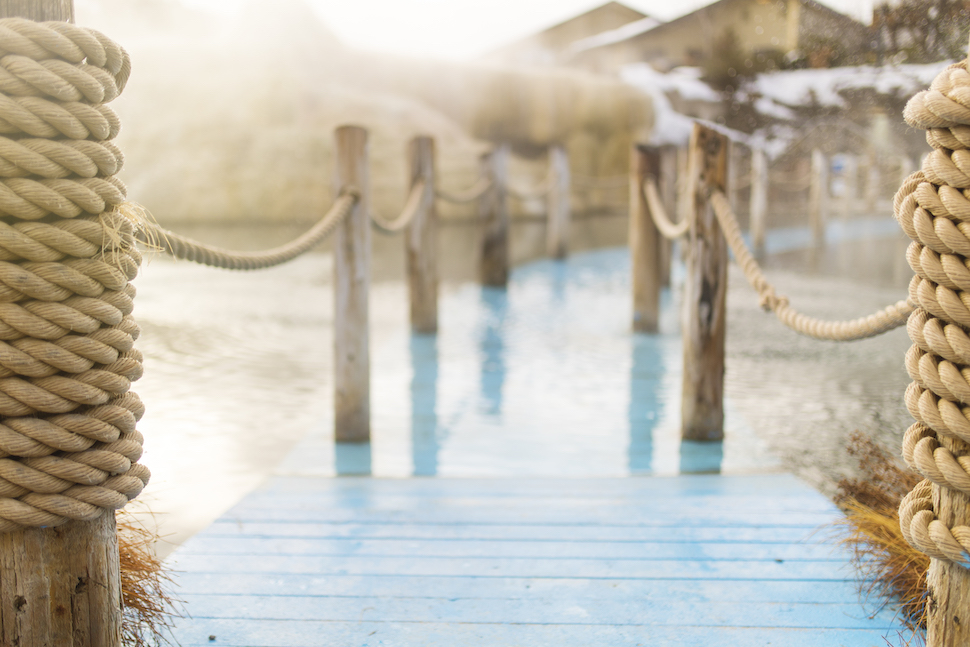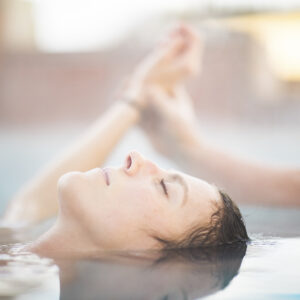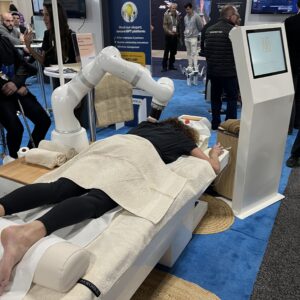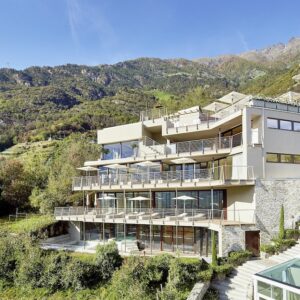
In the spa and wellness world, the New Year does not begin on January 1st, it begins when the Global Wellness Summit releases its trends report. It arrives when winter is at its mid-point and we are taking stock of the past and looking to the future. Most years, each trend is a bright line which, woven with others, shows us a larger truth.
For me, as I sit in my editor’s chair and assess the trends, this year is no different. The extreme forces I see shaping spa are Retro versus Techno. Both are good!
Let’s begin with deep retro—taking the waters. Balneology is finally taking off in one direction—the extreme opposite of high-tech. Much like the connoisseur who learns the best combination of water, temperature, and time to steep different kinds of teas and coffees, balneologists like Dr. Marcus Coplin, ND, of the Balneology Association of North America (BANA) have been promulgating the ideal combinations of water, temperatures, and times to heal people.

Aqua Massage at The Springs Resort in Pagosa Springs, Colorado
BANA defines balneology as “The science of therapeutic bathing in natural mineral waters, and the associated therapies including drinking, steam inhalation, peloid packs and climatology effects on health.” I’m hoping that this renewed interest in water and water therapies will spark more spas to invest in hydrotherapy equipment and education. (On that note, the Golden Door recently revamped its classic bathhouse and added a gleaming new Kohler Vichy shower.) For much too long in the US, spas have turned away from Vichy showers, hydrotherapy tubs, and the like. I can recall, years back, when Canyon Ranch Las Vegas tore out its two Watsu rooms to make way for more massage. Now, Watsu and water therapies are on the rise.
Case in point is the new Aqua Massage at The Springs Resort in Pagosa Springs, Colorado, that takes place in one of its 25 hot springs’ soaking pools. Sharon Holtz, Vice President of Wellness, is creating real magic. What I loved is that it is a massage—a remarkably blissful massage because the combination of body-temperature mineral waters and simple floats, placed behind your neck and under your knees, makes the experience gravity-free—like floating in the Dead Sea—and thus, in many ways, more nurturing than any massage table. It is one of the best treatments I can remember—even if it was cut short by a flash of lightning and a loud bang. That’s real retro!
Speaking of sound. Another retro-luxury extreme is the music-therapy massage at Palmaia Resort in Playa Del Carmen. The spa is built around a cenote and the glass wall of the treatment rooms give a sense of total immersion in the surrounding jungle. Everything feels handmade by people who care, and even the music is not recorded. On the contrary, the massage therapist is accompanied by a sound healer with a full set of singing bowls, rain sticks, maracas, and a beautiful voice. Truly transformative.

The Farm at Hokuala, once a golf course, at Timbers Kauai
Still another retro-extreme are golf resorts like Timbers Kauai that have torn up an entire 18-hole course and replaced it with a regenerative farm and walking trails. One reason is that a garden is better habitat for the myriad endangered birds that thrive on the property. The real reason is that it creates better habitat for guests. Fresh organic fruits and vegetables, obviously. More than that is the sense of community created by such things as named trees planted by guests, and a safe wild wood to explore. These days, a grand regenerative garden is a statement much like an Italian Renaissance garden—and one that is good for everyone and the planet.
On the techno-extreme is the perfection of AI touch. We have several competing AI bots on their way to giving decent massages using very different approaches to the market. One, from Aescape, has two “hands” and is designed to be done with clothes on. It learns what you like over time and gets better, so the massage should get ever more personalized over time. I had a 15-minute massage a year ago and can vividly recall the touch and feel of the massage—oddly, I can’t do that with a human therapist. I can recall an excellent therapist and a noteworthy massage, but not the exact feeling of a particular touch.
Another massage bot from Capsix Robotics has a single “hand” and is really designed to be used clothes off, with oil. To protect your privacy, it doesn’t gather data, and the first experience, according to Insider’s Editor at Large, Stephen Kiesling, was quite good. And AI learns fast. To go with these bots, we also have AI-generated music and immersive art (See GWS’s well-documented trend report by Ari Peralta, “A New Multisensory, Immersive Art for Wellness”). Not to mention beds and apps that can read every blink and catch every snore.

Meet iYU from Capsix Robotics
Looking ahead, real human touch—the retro language of spa—is going to get more expensive and elitist while the techno massage and AI environments will get cheaper and go mainstream. My guess is that machines will never become human. Because the human touch is never alien, and even the best bot will always be. There will always remain a fundamental difference between machine touch and human. In this category, techno will never beat retro.
Does a person really need an Oura Ring or a Bryte bed to tell them they’ve had a good night’s sleep? The answer right now, is probably “yes.” Our lives are so amped up we need massive amounts of data to tell us how we feel and what to do about it. We are also giving away so much of our power to bots that they know us better than we know ourselves . . . Face it, most of us are so far removed from ourselves that it takes ever better tech to allow us to reach way back and shut off the machines. Techno-retro.
And now there’s a proliferation of what’s called “touchless tech.” Machines and contraptions like the Somadome, BioCharger, MindSpa, and Prism Light Pod—all of which can be found at Carillon Miami, where Tammy Pahel, Vice President of Spa & Wellness Operations has been raising the touchless-tech bar since she first introduced a touchless wellness menu in 2020.
Speaking of touchless wellness. Last September, I was invited to judge the first-ever Touchless Wellness Awards, spearheaded by Steven Spiro, Founder and CEO of Halotherapy Solutions. The Awards were created “to recognize those embracing and pioneering touchless wellness modalities such as Halotherapy, Infrared Sauna Therapy, Red-Light Therapy, Float Therapy, and Cryotherapy.” There’s even a new association for this rapidly growing category—the Touchless Wellness Association (TWA), launched last October by Erin Lee, the former Executive Director of the World Halotherapy Association.
Let’s not forget our business is reality-based. And that the overwhelming global trend remains loneliness and anxiety. Loneliness is a public health crisis, and, according to US Surgeon General Dr. Vivek Murthy, it increases risk of premature death by more than 60 percent. Just this past year, Murthy called for action to address the crisis, laying out a framework for a national strategy to advance social connection. Meanwhile, McKinsey Health Institute reports that 548 million people experience symptoms of anxiety or depression and 33 percent of people worldwide feel lonely.
Face it, most of us are so far removed from ourselves that it takes ever better tech to allow us to reach way back and shut off the machines. Techno-retro.
Spa, of course, is uniquely positioned to help. So, here’s the big question: Do people come out feeling better than when they go in? And was it worth the money they spent? Now here’s the rub—do they even know, because the Instagram post is now more important than the experience? Which leads me to:
What actually connects beyond Instagram? That’s where the focus needs to stay, be it retro or techno. What actually connects? Where do we find community? We’re all aware that social spa-ing has been on the rise (though it makes me smile when I remember first writing about this trend from a spa-design perspective in the early 2000s, and one wonderful conversation in particular I had with Cary Collier, principal, BLU Spas).

The glorious six-story sauna tower at Preidlhof in South Tryrol, Italy
The Aufguss sauna experience is a perfect example of social spa-ing, and it made its US debut in 2021, at the Awana Spa at Resorts World Las Vegas, under the visionary guidance of spa director extraordinaire Jennifer Lynn. She then brought Aufguss to the new Lapis Spa at Fontainebleau Las Vegas, that opened a few months ago.
Although I traveled to Germany regularly for years, somehow, I never managed to experience this ritual until my spa time at Awana. It was wonderful and powerful—and it made me choke up—not from the extreme heat of the sauna, but from the sheer and overwhelming feeling of being in and experiencing something powerful and ancient and much bigger than me with a group of strangers who didn’t seem like strangers.
My Aufguss experience at Preidlhof in South Tyrol, Italy, elicited the same feeling—extreme joy and the feeling of belonging—whether I wanted to or not.
We’ve also reconnected with nature, thanks in large part to the pandemic. That reconnection to nature, reports the 2024 Wellness Trends, from Global Wellness Summit, is what’s driving the GWS trend “The Power of the Pilgrimage.” The report, written by Eric Wilson, describes this reconnection as a purposeful connection with nature.
To quote the report: “From a wellness perspective, this trend has serious legs: a pilgrimage is a metaphor for the path to enlightenment, engendering slow, meditative travel, and facilitating deeper engagement with our surroundings to foster a sense of awe. It also produces unexpected encounters with strangers that lead to a deeper perspective on the place of our ‘self’ in a very big world. Savvy resorts are now looking to pilgrimages, offering wellness programs that incorporate journeys between sacred sites, participation in religious services such as meditating with monks or almsgiving, and providing access to ceremonies once attainable only after years of experience on the path to enlightenment.”

SHA Wellness Clinic, L’Albir, Spain
Forget enlightenment. Let’s get intimate. Spa sex is heating up—and in a good way. SHA Wellness Clinic’s new Sexual Health Unit is dedicated to studying sexual wellbeing as part of optimizing overall health, desire, self-esteem, and sexual function. Skincare guru Pietro Simone’s new Intimate Menu is created “to support, correct, and enhance the delicate intimate area in men and women that is too often not discussed and left aside for many people, impacting their confidence,” Simone recently shared with me. “No shame, just confidence regained.”
And then there’s the “sex-positive” annual Nooner campaign at British Columbia-based Accent Inns. This year’s Valentine campaign is “Nooner: Come as You Are,” dedicated to solo sex. Mandy Farmer, CEO says that “We, as hoteliers, should be designing for it [sex] and finding ways to enhance that experience like we do with every other part of their stay.”
Totally retro solo is Marcello Murzilli’s Eremito Hotelito Del Alma, a real “singles” hotel in a monastery overlooking a UNESCO biosphere preserve in Umbria, Italy. Solo guests stay in monastic cells that have no refrigerator, television, phone, or air conditioning. And at night, candles! (Relax: no chamber pots, and there is a washroom and shower.) All meals are vegetarian—and silent—following Mediterranean monastic traditions. Eremito has been listed as one of the top eco-hotels in the world and maybe the world’s best hotel for a digital detox.
And then there’s this—Celibacy: “It’s this year’s hottest mental health craze,” per a recent piece in The New York Times, “She’s Not Celibate—She’s ‘Boysober.’” Good luck with that.
Totally techno! Weight drugs that work! Beth McGroarty, Vice President, Research and Forecasting, Global Wellness Institute, writes in the 2024 Wellness Trends, from Global Wellness Summit, “Equally astounding is how fast the new weight-loss drugs have upended the behavior-change-focused weight loss businesses, like gyms, dieting platforms and wellness resorts. Our trend analyzes their impact, how wellness businesses quickly pivoted to prescribe Big Pharma’s magic pills/‘pricks’ and what a healthier, integrative weight-loss approach might look like. Big gaps in healthcare are now opening big spaces for ‘hardcare’ in wellness, with a new, pricey concierge medicine now living under the wellness umbrella. It brings its own huge questions about access.”
A future of spa flashback. When asked about the future of spa back in 1999, the late great Alex Szekely, President, Rancho La Puerta, shared with me, “The baby boomer continues to drive the spa market. As they hit their mid-life crises, they’re trying to find new, more holistic ways of dealing with weight gain, keeping fit, and stress reduction. They’re looking for lifestyle techniques—how to better themselves . . . [the spa industry is] driven by boomers who aren’t willing to accept the way it used to be . . .”
Well, Boomers still drive a huge part of the market. The big shift here is from techniques to better ourselves to a fierce focus on longevity—how to live longer at all costs. Bottom line is Boomers raging against the dying of the light.
Mary Bemis
Mary Bemis is Founder & Editorial Director of InsidersGuidetoSpas.com. An advocate for all things spa, Mary forged a vocabulary for spa reportage that is widely used by those who cover the issues today. Recently honored as a Top 30 Influential Voice Transforming Wellness by Medika Life, Mary is an inaugural honoree of Folio’s Top Women in Media Award. Her spa media roots run deep—in 1997, she launched American Spa magazine, in 2007, she co-founded Organic Spa magazine, and in between serving on the ISPA and NYSPA Board of Directors, she was on the launch teams of Luxury SpaFinder and New Beauty magazines. Named a "Wonder Woman of Wellness" by American Spa magazine, Mary was honored by the International Spa Association with the distinguished ISPA Dedicated Contributor Award. She is a special advisor to the non-profit Global Wellness Day.
- Web |
- More Posts(82)